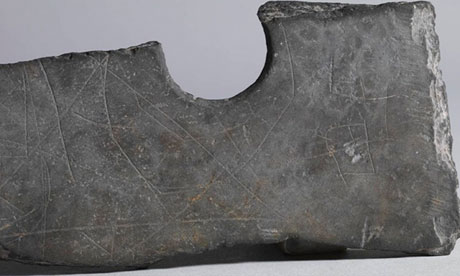Markings on artefacts from Zhuangqiao relics site date to 5,000 years ago and include string of words, says archaeologist

A stone axe from near the Zhuangqiao relics site, in east China, shows a newly discovered form of primitive writing, archaeologists say. Photograph: AP
Primitive inscriptions dating back about 5,000 years – and believed to be 1,400 years older than the most ancient written Chinese language – have been discovered in Shanghai, archaeologists report.
Chinese scholars are divided over whether the markings, found on artefacts at the Zhuangqiao relics site south of the modern city, are words or something simpler. But they believe the discovery will shed light on the origins of Chinese language and culture.
The oldest writing in the world is believed to be from Mesopotamia (now Iraq), dating back slightly more than 5,000 years. Chinese characters are believed to have been developed independently.
The Chinese inscriptions were found on more than 200 pieces dug out from the neolithic Liangzhu relics site. The pieces are among thousands of fragments of ceramic, stone, jade, wood, ivory and bone excavated from the site between 2003 and 2006, Xu Xinmin, the lead archaeologist, said.
Chinese scholars, of archaeology and ancient writing, who met last weekend in Zhejiang province to discuss the finding, thought the inscriptions did not indicate a developed writing system. However Xu said there was evidence of words on two pieces of stone axes.
One of the pieces has six word-like shapes strung together and resembles a short sentence.
"They are different from the symbols we have seen in the past on artefacts," Xu said. "The shapes, and the fact that they are in a sentence-like pattern, indicate they are expressions of some meaning."
The six characters are arranged in a line, and three resemble the modern Chinese character for human beings. Each shape has two to five strokes.
"If five to six of them are strung together like a sentence, they are no longer symbols but words," said Cao Jinyan, a scholar of ancient writing at Zhejiang University. He said the markings should be regarded as hieroglyphics.
He said there were also stand-alone shapes with more strokes. "If you look at the composition, you will see they are more than symbols."
But Liu Zhao, an archaeologist at Fudan University, Shanghai, suggested there was not sufficient material for a conclusion. "I don't think they should be considered writing by the strictest definition. We do not have enough material to pin down the stage of those markings in the history of ancient writings."
For now the Chinese scholars are calling the markings primitive writing, a vague term that suggests they are somewhere between symbols and words.
The oldest known Chinese writing has been found on animal bones (known as oracle bones) dating to 3,600 years ago, at the time of the Shang dynasty.
No comments:
Post a Comment